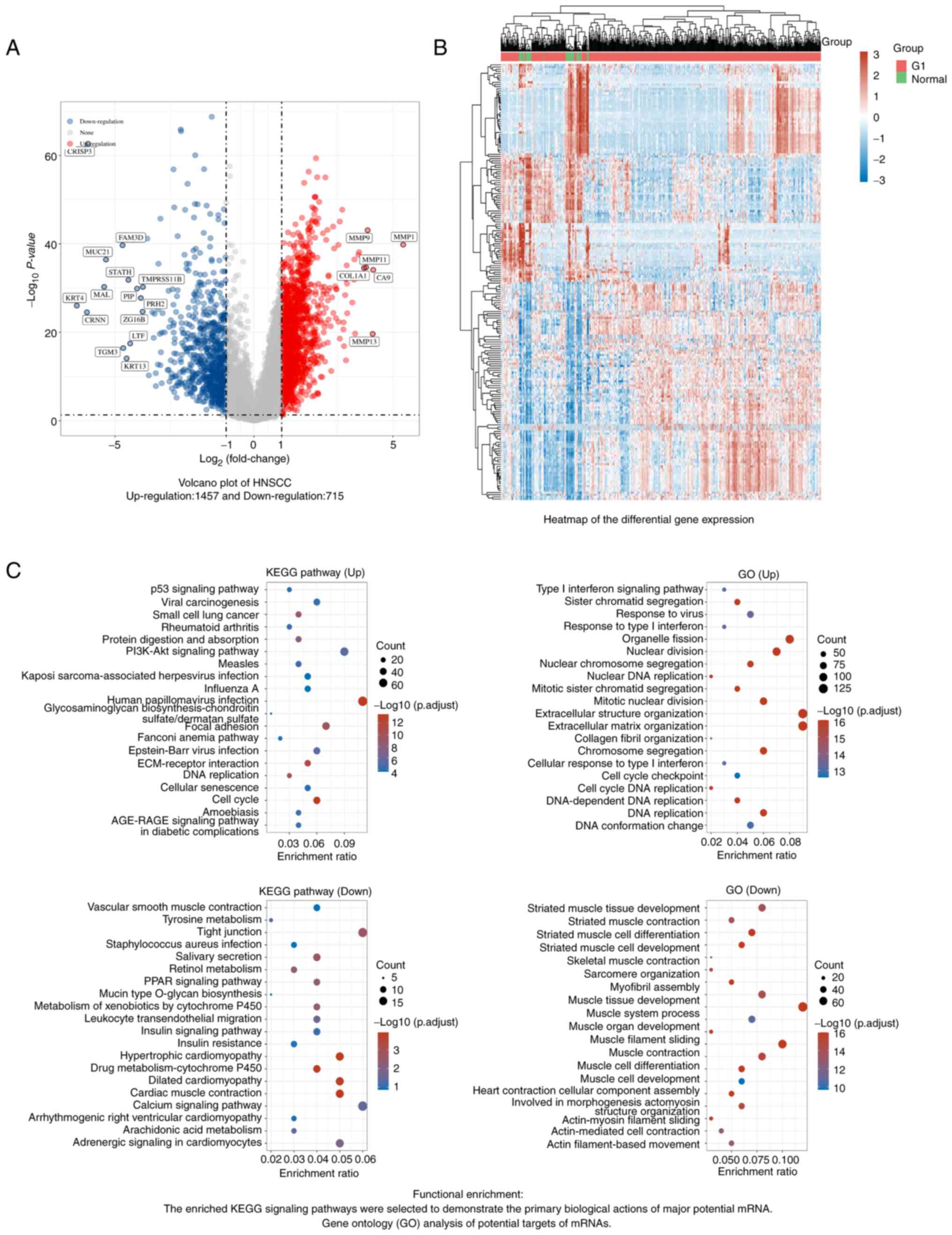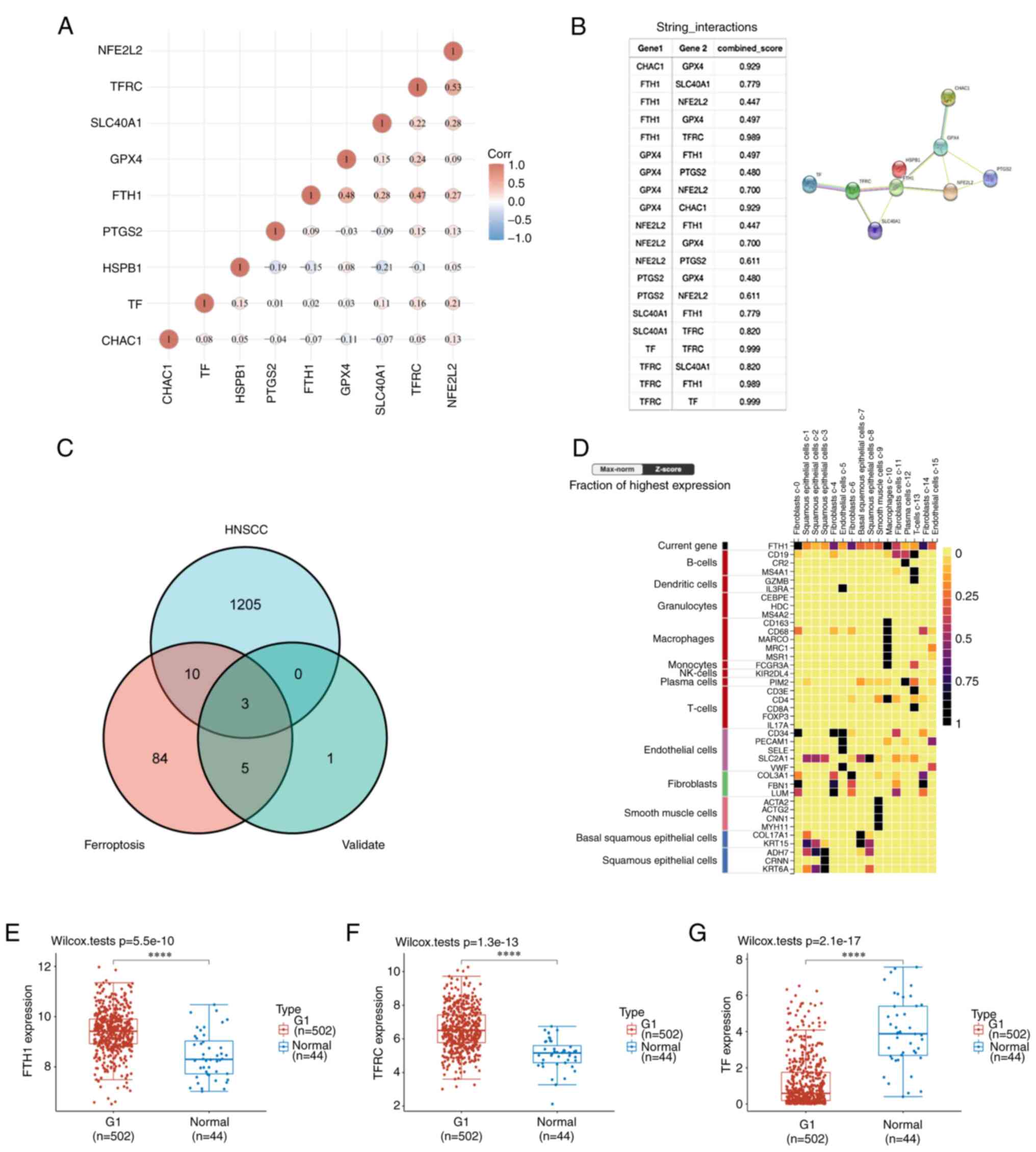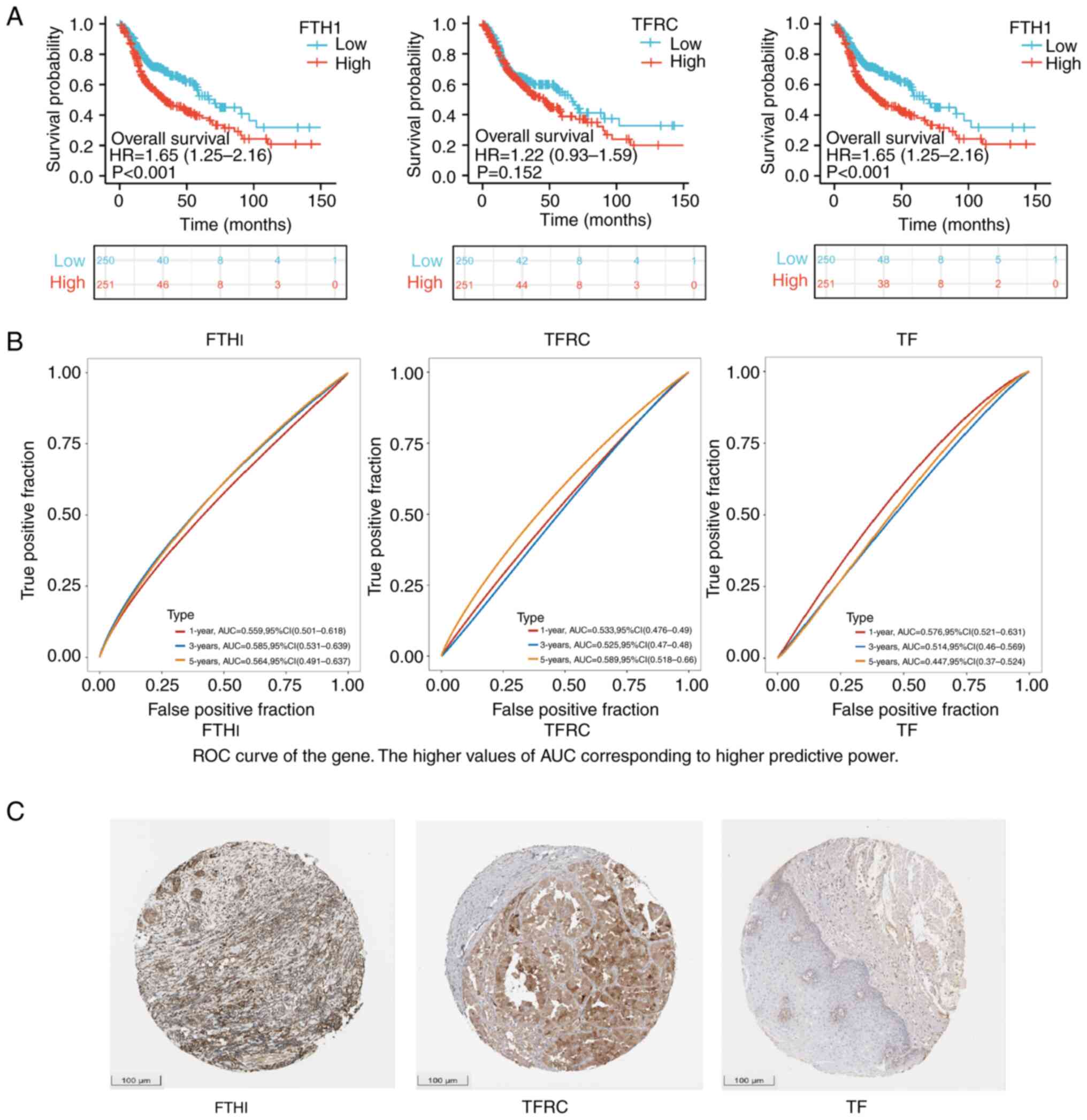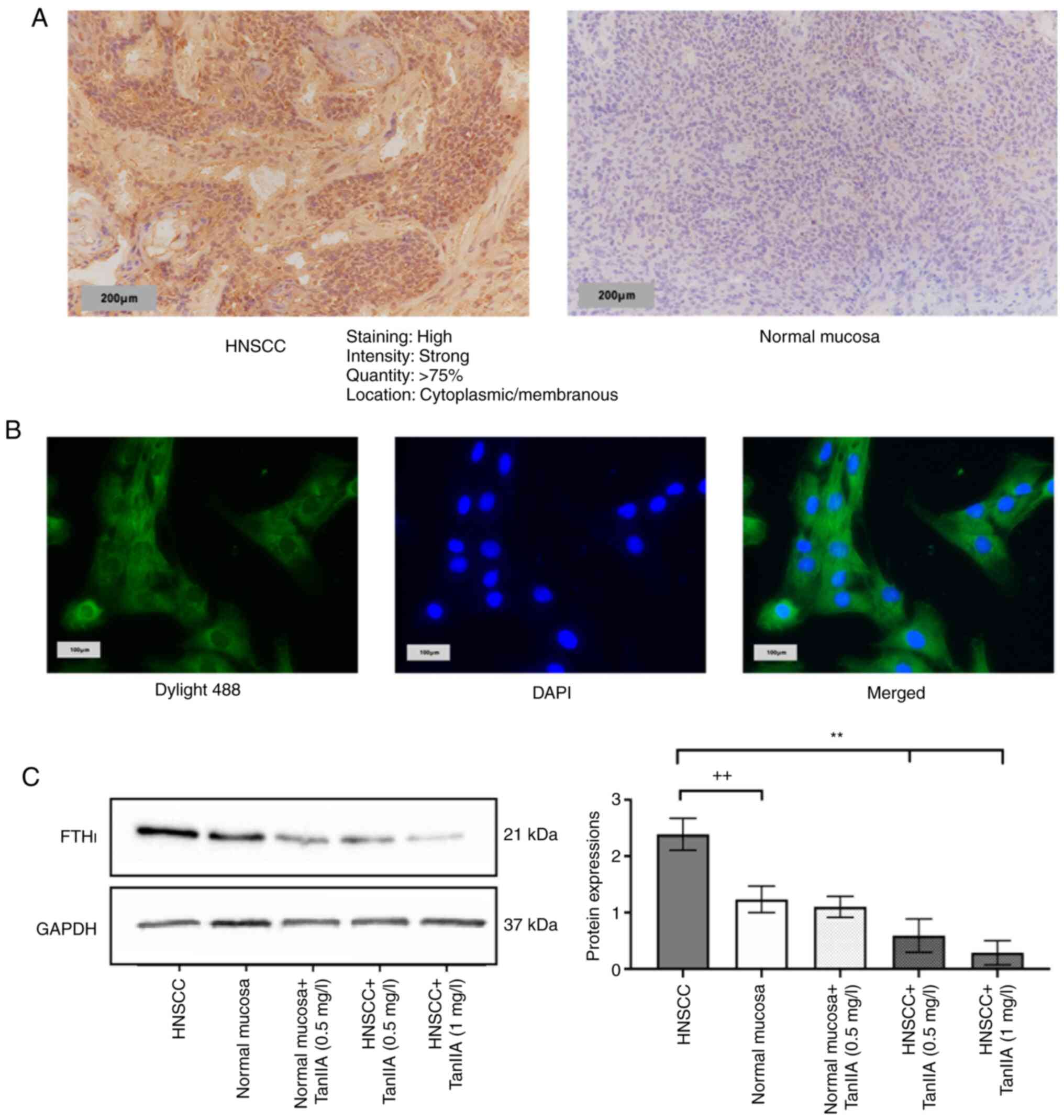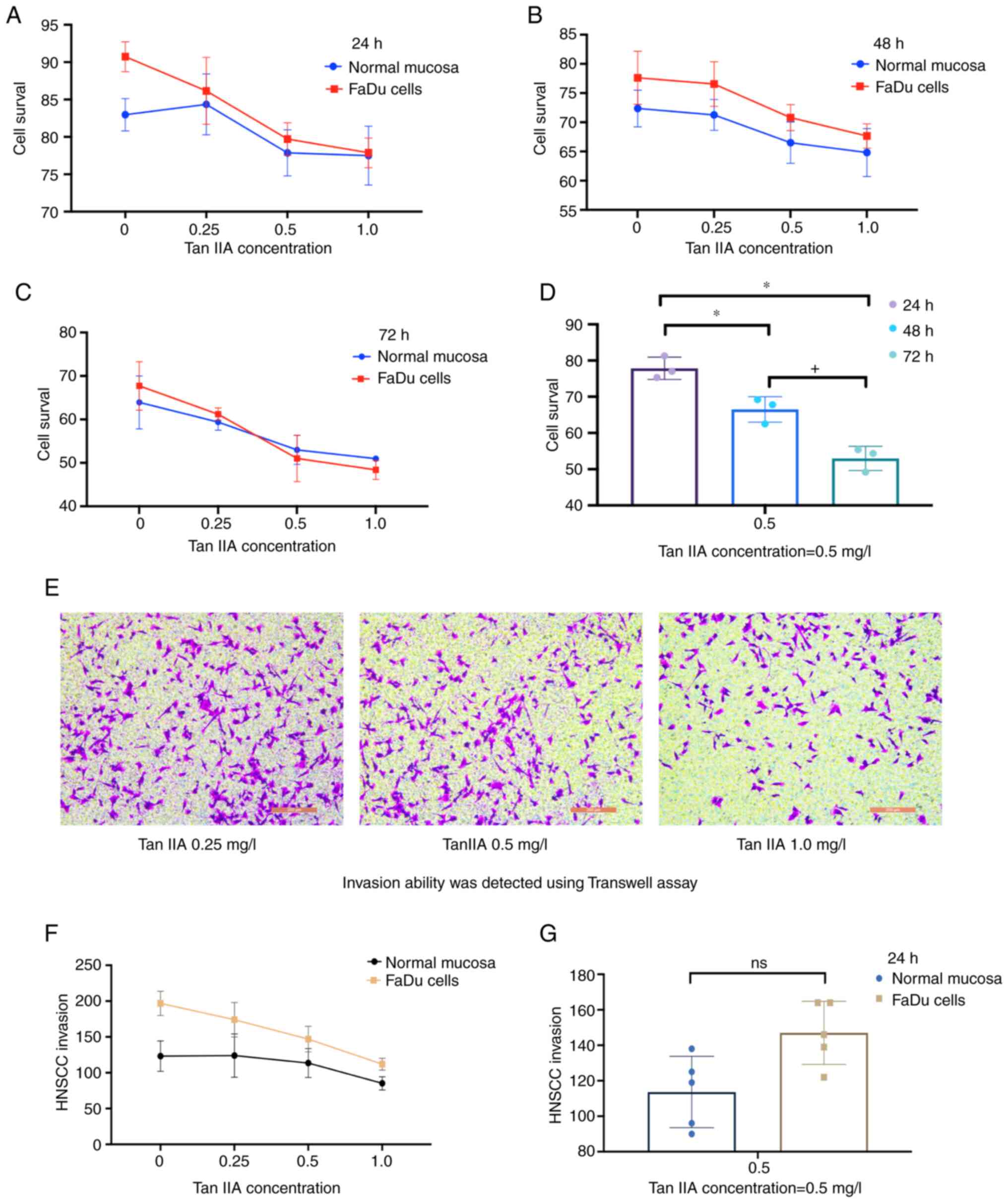|
1
|
Blanchard P, Landais C, Lacas B, Petit C,
Bourhis J and Pignon JP: SP-010: Update of the meta-analysis of
chemotherapy in head and neck cancer (MACH-NC). Radiother Oncol.
122(9)2017.
|
|
2
|
Ye J, Jiang X, Dong Z, Hu S and Xiao M:
Low-concentration PTX and RSL3 inhibits tumor cell growth
synergistically by inducing ferroptosis in mutant p53
hypopharyngeal squamous carcinoma. Cancer Manag Res. 11:9783–9792.
2019.PubMed/NCBI View Article : Google Scholar
|
|
3
|
Lee J, Ji HY, Kim MS and Roh JL:
Epigenetic reprogramming of epithelial-mesenchymal transition
promotes ferroptosis of head and neck cancer. Redox Biol.
37(101697)2020.PubMed/NCBI View Article : Google Scholar
|
|
4
|
Roh JL, Kim EH, Jang H and Shin D: Nrf2
inhibition reverses the resistance of cisplatin-resistant head and
neck cancer cells to artesunate-induced ferroptosis. Redox Biol.
11:254–262. 2017.PubMed/NCBI View Article : Google Scholar
|
|
5
|
Mou Y, Wang J, Wu J, He D, Zhang C, Duan C
and Li B: Ferroptosis, a new form of cell death: Opportunities and
challenges in cancer. J Hematol Oncol. 12(34)2019.PubMed/NCBI View Article : Google Scholar
|
|
6
|
Kong N, Chen X, Feng J, Duan T, Liu S, Sun
X, Chen P, Pan T, Yan L, Jin T, et al: Baicalin induces ferroptosis
in bladder cancer cells by downregulating FTH1. Acta Pharm Sin B.
11:4045–4054. 2021.PubMed/NCBI View Article : Google Scholar
|
|
7
|
Zhu S, Yu Q, Huo C, Li Y, He L, Ran B,
Chen J, Li Y and Liu W: Ferroptosis: A novel mechanism of
artemisinin and its derivatives in cancer therapy. Curr Med Chem.
28:329–345. 2021.PubMed/NCBI View Article : Google Scholar
|
|
8
|
Guan Z, Chen J, Li X and Dong N:
Tanshinone IIA induces ferroptosis in gastric cancer cells through
p53-mediated SLC7A11 down-regulation. Biosci Rep.
40(BSR20201807)2020.PubMed/NCBI View Article : Google Scholar
|
|
9
|
Qian J, Cao Y, Zhang J, Li L, Wu J, Wei G,
Yu J and Huo J: Tanshinone IIA induces autophagy in colon cancer
cells through MEK/ERK/mTOR pathway. Transl Cancer Res. 9:6919–6928.
2020.PubMed/NCBI View Article : Google Scholar
|
|
10
|
Zhao YX, Luo D, Zhang YH, Shen B, Wang BX
and Sun ZF: The effect of tanshinone ⅡA potentiates the effects of
cisplatin in Fadu cells in vitro through downregulation of
survivin. Lin Chung Er Bi Yan Hou Tou Jing Wai Ke Za Zhi.
31:781–784. 2017.PubMed/NCBI View Article : Google Scholar : (In Chinese).
|
|
11
|
He L, Liu YY, Wang K, Li C, Zhang W, Li
ZZ, Huang XZ and Xiong Y: Tanshinone IIA protects human coronary
artery endothelial cells from ferroptosis by activating the NRF2
pathway. Biochem Biophys Res Commun. 575:1–7. 2021.PubMed/NCBI View Article : Google Scholar
|
|
12
|
Zhou N and Bao J: FerrDb: A manually
curated resource for regulators and markers of ferroptosis and
ferroptosis-disease associations. Database (Oxford).
2020(baaa021)2020.PubMed/NCBI View Article : Google Scholar
|
|
13
|
von Mering C, Huynen M, Jaeggi D, Schmidt
S, Bork P and Snel B: STRING: A database of predicted functional
associations between proteins. Nucleic Acids Res. 31:258–261.
2003.PubMed/NCBI View Article : Google Scholar
|
|
14
|
Shannon P, Markiel A, Ozier O, Baliga NS,
Wang JT, Ramage D, Amin N, Schwikowski B and Ideker T: Cytoscape: A
software environment for integrated models of biomolecular
interaction networks. Genome Res. 13:2498–2504. 2003.PubMed/NCBI View Article : Google Scholar
|
|
15
|
Obuchowski NA and Bullen JA: Receiver
operating characteristic (ROC) curves: Review of methods with
applications in diagnostic medicine. Phys Med Biol.
63(07TR01)2018.PubMed/NCBI View Article : Google Scholar
|
|
16
|
Uhlen M, Oksvold P, Fagerberg L, Lundberg
E, Jonasson K, Forsberg M, Zwahlen M, Kampf C, Wester K, Hober S,
et al: Towards a knowledge-based human protein atlas. Nat
Biotechnol. 28:1248–1250. 2010.PubMed/NCBI View Article : Google Scholar
|
|
17
|
Xu LP: Studies on the inhibition of AT#9
on three tumour cells proliferation by cell counting-kit 8. Journal
of North Pharmacy. 9:43–44. 2012.(In Chinese).
|
|
18
|
Di Sanzo M, Quaresima B, Biamonte F,
Palmieri C and Faniello MC: FTH1 pseudogenes in cancer and cell
metabolism. Cells. 9(2554)2020.PubMed/NCBI View Article : Google Scholar
|
|
19
|
Liu C, Guo T, Xu G, Sakai A, Ren S,
Fukusumi T, Ando M, Sadat S, Saito Y, Khan Z, et al:
Characterization of alternative splicing events in HPV-negative
head and neck squamous cell carcinoma identifies an oncogenic DOCK5
variant. Clin Cancer Res. 24:5123–5132. 2018.PubMed/NCBI View Article : Google Scholar
|
|
20
|
Hassannia B, Vandenabeele P and
Vanden*Berghe T: Targeting ferroptosis to iron out cancer. Cancer
Cell. 35:830–849. 2019.PubMed/NCBI View Article : Google Scholar
|
|
21
|
Zhang K, Ping L, Du T, Liang G, Huang Y,
Li Z, Deng R and Tang J: A ferroptosis-related lncRNAs signature
predicts prognosis and immune microenvironment for breast cancer.
Front Mol Biosci. 8(678877)2021.PubMed/NCBI View Article : Google Scholar
|
|
22
|
Jiang X, Stockwell BR and Conrad M:
Ferroptosis: Mechanisms, biology and role in disease. Nat Rev Mol
Cell Biol. 22:266–282. 2021.PubMed/NCBI View Article : Google Scholar
|
|
23
|
Zhao YY, Lian JX, Lan Z, Zou KL, Wang WM
and Yu GT: Ferroptosis promotes anti-tumor immune response by
inducing immunogenic exposure in HNSCC. Oral Dis: Nov 12, 2021
(Epub ahead of print).
|
|
24
|
Tang Y, Li C, Zhang YJ and Wu ZH:
Ferroptosis-related long non-coding RNA signature predicts the
prognosis of head and neck squamous cell carcinoma. Int J Biol Sci.
17:702–711. 2021.PubMed/NCBI View Article : Google Scholar
|
|
25
|
Ni H, Ruan G, Sun C, Yang X, Miao Z, Li J,
Chen Y, Qin H, Liu Y, Zhang L, et al: Tanshinone IIA inhibits
gastric cancer cell stemness through inducing ferroptosis. Environ
Toxicol. 37:192–200. 2022.PubMed/NCBI View Article : Google Scholar
|
|
26
|
Jiang Y, Mao C, Yang R, Yan B, Shi Y, Liu
X, Lai W, Liu Y, Wang X, Xiao D, et al: EGLN1/c-Myc induced
lymphoid-specific helicase inhibits ferroptosis through lipid
metabolic gene expression changes. Theranostics. 7:3293–3305.
2017.PubMed/NCBI View Article : Google Scholar
|
|
27
|
Plays M, Müller S and Rodriguez R:
Chemistry and biology of ferritin. Metallomics.
13(mfab021)2021.PubMed/NCBI View Article : Google Scholar
|
|
28
|
Scaramuzzino L, Lucchino V, Scalise S,
Conte ML, Zannino C, Sacco A, Biamonte F, Parrotta EI, Costanzo FS
and Cuda G: Dissecting the molecular response of human Escs to
iron-mediated oxidative stress by genetic silencing of FTH1 gene.
Res Sq. 1:1–28. 2021.
|
|
29
|
Lee JH, Jang H, Cho EJ and Youn HD:
Ferritin binds and activates p53 under oxidative stress. Biochem
Biophys Res Commun. 389:399–404. 2009.PubMed/NCBI View Article : Google Scholar
|
|
30
|
Di Sanzo M, Aversa I, Santamaria G,
Gagliardi M, Panebianco M, Biamonte F, Zolea F, Faniello MC, Cuda G
and Costanzo F: FTH1P3, a novel H-ferritin pseudogene
transcriptionally active, is ubiquitously expressed and regulated
during cell differentiation. PLoS One. 11(e0151359)2016.PubMed/NCBI View Article : Google Scholar
|
|
31
|
Mu T, Qin Y, Liu B, He X, Liao Y, Sun J,
Qiu J, Li X, Zhong Y and Cai J: In vitro neural differentiation of
bone marrow mesenchymal stem cells carrying the FTH1 reporter gene
and detection with MRI. Biomed Res Int.
2018(1978602)2018.PubMed/NCBI View Article : Google Scholar
|
|
32
|
Yang L, Sun K, Chu J, Qu Y, Zhao X, Yin H,
Ming L, Wan J and He F: Long non-coding RNA FTH1P3 regulated
metastasis and invasion of esophageal squamous cell carcinoma
through SP1/NF-kB pathway. Biomed Pharmacother. 106:1570–1577.
2018.PubMed/NCBI View Article : Google Scholar
|
|
33
|
Zhang CZ: Long non-coding RNA FTH1P3
facilitates oral squamous cell carcinoma progression by acting as a
molecular sponge of miR-224-5p to modulate fizzled 5 expression.
Gene. 607:47–55. 2017.PubMed/NCBI View Article : Google Scholar
|
|
34
|
Muhammad JS, Bajbouj K, Shafarin J and
Hamad M: Estrogen-induced epigenetic silencing of FTH1 and TFRC
genes reduces liver cancer cell growth and survival. Epigenetics.
15:1302–1318. 2020.PubMed/NCBI View Article : Google Scholar
|
|
35
|
Li J, Lama R, Galster SL, Inigo JR, Wu J,
Chandra D, Chemler SR and Wang X: Small-molecule MMRi62 induces
ferroptosis and inhibits metastasis in pancreatic cancer via
degradation of ferritin heavy chain and mutant p53. Mol Cancer
Ther. 21:535–455. 2022.PubMed/NCBI View Article : Google Scholar
|
|
36
|
Huang HX, Yang G, Yang Y, Yan J, Tang XY
and Pan Q: TFAP2A is a novel regulator that modulates ferroptosis
in gallbladder carcinoma cells via the Nrf2 signalling axis. Eur
Rev Med Pharmacol Sci. 24:4745–4755. 2020.PubMed/NCBI View Article : Google Scholar
|
|
37
|
Ansari MA, Khan FB, Safdari HA, Almatroudi
A, Alzohairy MA, Safdari M, Amirizadeh M, Rehman S, Equbal MJ and
Hoque M: Prospective therapeutic potential of Tanshinone IIA: An
updated overview. Pharmacol Res. 164(105364)2021.PubMed/NCBI View Article : Google Scholar
|
|
38
|
Zhang Y, Jiang P, Ye M, Kim SH, Jiang C
and Lü J: Tanshinones: Sources, pharmacokinetics and anti-cancer
activities. Int J Mol Sci. 13:13621–13666. 2012.PubMed/NCBI View Article : Google Scholar
|
|
39
|
Che XH, Park EJ, Zhao YZ, Kim WH and Sohn
DH: Tanshinone II A induces apoptosis and S phase cell cycle arrest
in activated rat hepatic stellate cells. Basic Clin Pharmacol
Toxicol. 106:30–37. 2010.PubMed/NCBI View Article : Google Scholar
|
|
40
|
Won SH, Lee HJ, Jeong SJ, Lee HJ, Lee EO,
Jung DB, Shin JM, Kwon TR, Yun SM, Lee MH, et al: Tanshinone IIA
induces mitochondria dependent apoptosis in prostate cancer cells
in association with an inhibition of phosphoinositide 3-kinase/AKT
pathway. Biol Pharm Bull. 33:1828–1834. 2010.PubMed/NCBI View Article : Google Scholar
|
|
41
|
Sui H, Zhao J, Zhou L, Wen H, Deng W, Li
C, Ji Q, Liu X, Feng Y, Chai N, et al: Tanshinone IIA inhibits
β-catenin/VEGF-mediated angiogenesis by targeting TGF-β1 in
normoxic and HIF-1α in hypoxic microenvironments in human
colorectal cancer. Cancer Lett. 403:86–97. 2017.PubMed/NCBI View Article : Google Scholar
|
|
42
|
Fan Q, Fan GJ, Yang PM and Zhao JY: Effect
of tanshinone microemulsion on reversing MDR in human tumor cells.
Zhongguo Zhong Yao Za Zhi. 29:1079–1081. 2004.PubMed/NCBI(In Chinese).
|
|
43
|
Xu H, Hao YL, Xu LN, Chen L and Xu FW:
Tanshinone sensitized the antitumor effects of irradiation on
laryngeal cancer via JNK pathway. Cancer Med. 7:5187–5193.
2018.PubMed/NCBI View Article : Google Scholar
|
|
44
|
Ding L, Wang S, Qu X and Wang J:
Tanshinone IIA sensitizes oral squamous cell carcinoma to radiation
due to an enhanced autophagy. Environ Toxicol Pharmacol.
46:264–269. 2016.PubMed/NCBI View Article : Google Scholar
|
|
45
|
Johnson DE, Burtness B, Leemans CR, Lui
VWY, Bauman JE and Grandis JR: Head and neck squamous cell
carcinoma. Nat Rev Dis Primers. 6(92)2020.PubMed/NCBI View Article : Google Scholar
|
|
46
|
Ortiz-Cuaran S, Bouaoud J, Karabajakian A,
Fayette J and Saintigny P: Precision medicine approaches to
overcome resistance to therapy in head and neck cancers. Front
Oncol. 11(614332)2021.PubMed/NCBI View Article : Google Scholar
|
|
47
|
Gougis P, Moreau Bachelard C, Kamal M, Gan
HK, Borcoman E, Torossian N, Bièche I and Le*Tourneau C: Clinical
development of molecular targeted therapy in head and neck squamous
cell carcinoma. JNCI Cancer Spectr. 3(pkz055)2019.PubMed/NCBI View Article : Google Scholar
|
|
48
|
Li X, Si W, Li Z, Tian Y, Liu X, Ye S,
Huang Z, Ji Y, Zhao C, Hao X, et al: miR-335 promotes ferroptosis
by targeting ferritin heavy chain 1 in in vivo and in
vitro models of Parkinson's disease. Int J Mol Med.
47(61)2021.PubMed/NCBI View Article : Google Scholar
|















